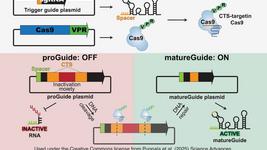CMN Weekly (22 March 2024) - Your Weekly CRISPR Medicine News
By: Gorm Palmgren - Mar. 22, 2024
Top picks
- Massachusetts General Hospital announced the world's first successful transplant of a CRISPR-Cas9-edited pig kidney into a 62-year-old man with end-stage kidney disease, marking a significant advance in organ transplantation. The pig kidney, modified by eGenesis to improve human compatibility and eliminate infection risks, offers new hope for addressing organ shortages. The patient, Richard Slayman, is recovering, highlighting the potential of xenotransplantation to alleviate the transplant waiting list crisis and improve health equity.
- CRISPR has been demonstrated to power a quantitative keyword search engine in DNA data storage. Search Enabled by Enzymatic Keyword Recognition (SEEKER) utilises CRISPR-Cas12a to rapidly generate visible fluorescence when a DNA target corresponding to the keyword of interest is present. Using four queries, it correctly identified keywords in 40 files with a background of ~8000 irrelevant terms.
Research
- CRISPR-knockout screening has identified ARF4, a key player in retrograde trafficking, as instrumental in TMZ resistance in glioblastoma (GBM). Inhibiting ARF4 in patient-derived xenograft models notably improved TMZ sensitivity and survival. Further investigations linked ARF4's role to enhanced EGFR nuclear trafficking and subsequent activation of DNA-PK, a factor in TMZ resistance. Targeting this pathway, particularly with DNA-PK inhibitors, emerged as a promising approach to counter chemoresistance in GBM.
- At the upcoming ECCMID 2024 in Barcelona, Dutch researchers will present a breakthrough in HIV treatment, demonstrating that CRISPR-Cas gene editing can eliminate HIV from infected cells in the lab. The team tested various CRISPR-Cas systems, finding saCas9 particularly effective in inactivating HIV and targeting latent reservoir cells. This proof of concept paves the way for future clinical trials, aiming for a safe, efficient HIV cure strategy.
- Using CRISPR-Cas9, American researchers created mouse lung tissue in rat hosts by introducing mouse embryonic stem cells into rat embryos with a disrupted Nkx2-1 gene. This interspecies chimaera approach resulted in a nearly complete mouse cell contribution to lung tissue, showcasing a potential method for growing human organs in large animals.
- Researchers in the USA have used CRISPR-Cas9 to introduce the Abca7V1613M variant in mice, mimicking a human variant linked to Alzheimer's disease. These mice showed enhanced microglial phagocytosis, altered lipid profiles, and, when combined with an Alzheimer's disease model, reduced amyloid pathology and neuroinflammation. This suggests that Abca7V1613M might protect against Alzheimer's by modulating immune responses and lipid metabolism.
- Chinese researchers have used CRISPR-Cas9 to delete the Apoa5 gene in Syrian golden hamsters, revealing its crucial role in triglyceride regulation and the development of nonalcoholic fatty liver disease (NAFLD). ApoA5-deficient hamsters showed severe hypertriglyceridemia and steatohepatitis, especially under a high-fat diet. This condition was linked to disrupted NR1D1 stability, a key molecular mechanism.
- Investigating the impact of culture resting times on the engraftment efficiency of CRISPR-Cas9 edited human CD34+ HSPCs at the BCL11A enhancer, American researchers found that immediate transplantation post-editing enhances engraftment without affecting editing efficacy. Extended culture post-electroporation led to significant cell loss, particularly in the hematopoietic stem cell-enriched fraction.
- Researchers in China have demonstrated that deactivated Cas9 (dCas9) can precisely control Cas3-mediated large-fragment deletions in mammalian cells. They also report the elimination of the Y chromosome and precise retention of the Sry gene in mice using CRISPR-Cas3 and dCas9-controlled CRISPR-Cas3, respectively.
- Short-hairpin RNAs (shRNA) have been used to reduce anxiety and boost memory. shRNA can silence genes by RNA interference (RNAi), and after targeting them to the 5-HT2A serotonin receptor gene (HTR2A) in the brains of mice and rats, the animals enhanced their memory twofold and significantly reduced signs of anxiety.
- Light-activated, inside-out nanoparticles have been used to spatially control CRISPR in mice's brains. Oligonucleotides complementary to the sgRNA of interest were attached to the surface of gold nanoparticles before annealing them to sgRNA:Cas9 ribonucleoprotein (RNP) complexes. After intranasal delivery, irradiation with near-infrared light caused the annealed strands to dissociate from each other, thereby releasing the RNP.
- A new approach combines CRISPR-Cas9 and natural excision to precisely and completely remove mobile genetic elements (MGEs) in bacteria. sgRNA targeting a 20-nucleotide region in the MGE sequence enables precise and complete elimination through Cas9 cleavage of both the integrative and circular forms of MGEs, generating MGE-removed cells.
- American researchers have demonstrated that CRISPR-Cas9 knockdown of TLR3 pathways in mice's dorsal striatum (DS) reduces ethanol intake and alters the response to alcohol, unlike in other brain regions. This suggests that brain Tlr3, especially within DS neurons, plays a critical role in regulating alcohol consumption, offering a potential target for curbing excessive drinking.
- Indian researchers describe a CRISPR-dCas13 strategy to enhance or induce stop codon readthrough (SCR) in a transcript-selective manner. They demonstrate the utility of this strategy in inducing readthrough across the thalassemia-causing PTC in HBB mRNA and hereditary spherocytosis-causing PTC in SPTA1 mRNA.
- A Japanese study leveraging long-read nanopore sequencing and CRISPR-Cas9 successfully targeted and sequenced genes linked to familial hypercholesterolemia, specifically LDLR and PCSK9, without amplification. This method overcame the limitations of conventional genetic testing by directly detecting both small mutations and a significant 11,029 bp deletion.
Industry
- Intellia Therapeutics reports having dosed the first patient in the phase 3 MAGNITUDE study of NTLA-2001. This single-dose CRISPR-based therapy inactivates the TTR gene, thereby preventing the production of TTR protein for the treatment of transthyretin (ATTR) amyloidosis with cardiomyopathy. Previous data from the phase 1 trial demonstrated deep and durable reductions of the TTR protein.
- Vertex Pharmaceuticals Incorporated announces FDA clearance of the Investigational New Drug Application (IND) for VX-407. VX-407 is an investigational first-in-class small molecule corrector that targets the underlying cause of autosomal dominant polycystic kidney disease (ADPKD) in patients with a subset of PKD1 genetic variants.
2023 financial updates
- Vor Bio has reported full-year 2023 financial results with a net loss of $118 million and $137 million in cash at the end of the year.
Detection
- Chinese researchers have developed a CRISPR-Cas12a-based immobilisation-free and label-free strategy to construct a photoelectrochemical nucleic acid biosensing platform based on interactions between silver nanoparticles and DNA. The developed platform exhibits a detection limit of 0.06 nM with commendable selectivity.
- Researchers in China have developed two rapid, sensitive and easy-to-conduct methods for Nipah virus (NiV) detection. They are based on a recombinase-aided amplification (RAA) assay and a CRISPR-Cas12a system by utilising dual-labeled fluorophore-quencher or fluorophore-biotin ssDNA probes.
Reviews
- Targeted Gene Insertion: The Cutting Edge of CRISPR Drug Development with Hemophilia as a Highlight. This paper reviews the recent advances in preclinical studies demonstrating in vivo targeted gene insertion for therapeutic benefits, targeting somatic solid tissues through systemic delivery.
- MicroRNA Sensors Based on CRISPR/Cas12a Technologies: Evolution From Indirect to Direct Detection. This review provides an overview of the evolution of biosensors based on CRISPR-Cas12a for miRNA detection from indirect to direct, which would benefit the development of CRISPR-Cas12a-based sensors with better performance for direct detection of miRNA.
- CRISPR activation screens: navigating technologies and applications. This review offers a brief technological overview of available CRISPRa architectures and a comprehensive summary of pooled CRISPRa screens. It also discusses contemporary applications of CRISPRa across broad fields of research.
- Gene Editing for the Treatment of Hypercholesterolemia. This review focuses on CRISPR-Cas9-mediated approaches to lower LDL cholesterol levels and reduce the risk of atherosclerotic cardiovascular disease. It highlights both the promising outcomes and the need for ensuring safety before clinical application.
News from CRISPR Medicine News
- On Monday, we brought an interview with the German team behind an innovative gene-editing approach that fuses non-specific recombinases with zinc finger domains (ZFDs). The combined enzyme is highly specific, and as recombination is independent of the cell's DNA repair pathways and does not require double-strand breaks, it avoids potential DNA damage and reduces toxicity.
To get more of the CRISPR Medicine News delivered to your inbox, sign up to the free weekly CMN Newsletter here.
Tags
CLINICAL TRIALS
IND Enabling
Phase I
Phase II
Phase III
Gastric Cancer and Colorectal Cancer, CRC, (NCT07166263)
Sponsors:
Base Therapeutics (Shanghai) Co., Ltd.
Sponsors:
Base Therapeutics (Shanghai) Co., Ltd.
IND Enabling
Phase I
Phase II
Phase III
Relapsed or Refractory Acute Myeloid Leukemia, AML, (NCT06541444)
Sponsors:
Base Therapeutics (Shanghai) Co., Ltd.
Sponsors:
Base Therapeutics (Shanghai) Co., Ltd.
IND Enabling
Phase I
Phase II
Phase III







